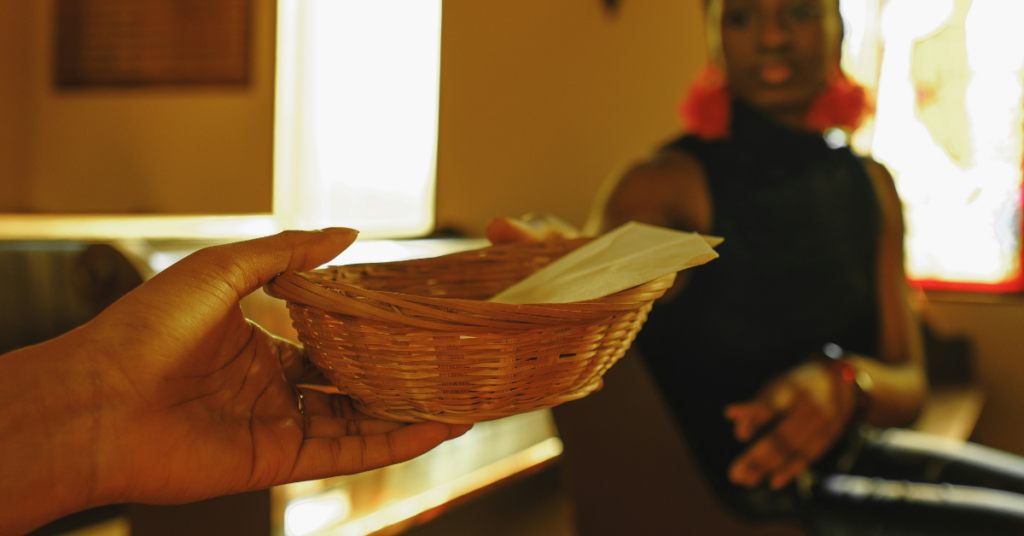“You know,” he said to me privately, hushing his voice, “it’s kind of a moot point.” People shuffled around us and by us, grabbing their coffees and packing their bags to head to the next workshop. “Almost seventy percent of our regular givers give their offering electronically these days. It makes no sense to pass a plate anymore.”
I had just finished wrapping up a workshop on how The Offering functions within the liturgical flow of regular worship, and here I was already wondering if I’d failed to make my point!
“I hear you,” I said honestly, “but I’m curious what we imagine The Offering is for, what is its function?”
What is its function?
I think if you ask the majority of churchgoers in the American context what the function of collecting an offering is, they’d tell you earnestly and matter-of-factly that the offering is collected primarily to “pay the bills.”
“Pay the bills.” That ho-hum phrase that all of us utter at one point or another as we sign another check to send off to who knows where, spending our hard-earned money to offset some sort of debt, utility, or benefit that are often underwhelming at best and not enough at worst.
I’ll be perfectly frank. If The Offering is collected primarily to “pay the bills,” count me out. The key word there is primarily, of course. There is certainly a utilitarian aspect to gifts collected, especially in the American context, but if we imagine that is what The Offering is for, it’s no wonder we fret about numbers and it’s no wonder we have reluctant givers (or are reluctant ourselves!).
In the tradition of our Jewish brothers and sisters, the Karbanot, or Offering, served three main functions within the giver:
- Renunciation of the idea that full bank accounts will save us. Willful giving from a full bank account explicitly rejects that idea.
- Paying for sins to cancel them out. With the Reformation the Lutheran tradition has rejected the idea that there is some sort of “sin-debt” that can be rectified by paying it off. Yet, regrets that strike close to the heart move people to take action, sometimes with their pocketbooks.
- Closeness to God. The Offering, as an act of love, brought the giver close to the God who also gives in so many ways in this world.
The current practice of giving The Offering has echoes of these three meaningful understandings reverberating in its liturgical bones, though certainly highlighting these ways that generosity is good for the giver’s soul could bear some repetition within hallowed halls. If 2 Corinthians is true, and the Divine does desire cheerful giving of ourselves, then obligation and “bill paying” can’t be the primary function of The Offering within the worship service.
Liturgical Flow: Word – Offering – Eucharist
The Offering within the Christian liturgy is primarily the opportunity for the hearer to tangibly respond in practical gratitude to the intangible and impractical grace of the Word heard and proclaimed.
Amount is not the point. The way it is collected is not even the point, as many churches have stopped passing the plate in these waning pandemic days. But the opportunity to tangibly respond to God’s Word proclaimed is a necessary part of the liturgy bridging the two peaks of the service: The Word and The Eucharist.
The Offering is where these two poles meet for a brief second and mere mortals are invited to give of themselves to the God who has given so much. For Christians who follow Jesus, The Offering operates in the liturgy as a response to the Good News of the Gospel.
So – How do we provide space for this response in our worship services?
Pass the Plate: One simple way to do so is to resume collecting an offering during the liturgy through passing the plate. For those who give electronically, a laminated “I Give Online” card can be available in the pew for reuse every week so that everyone has something to tangibly give.
Offering Stations: A second way might be to have stations around the sanctuary for people to offer something. An offering plate at one (or electronic kiosk for giving), a volunteer list at another, and perhaps a station where people can offer praises on a board for God’s goodness.
Testimony: During The Offering within your liturgy – however you choose to do it, share a brief story of a life changed. How has God shown up in the life of someone in your community? These stories are powerful, transformative, and remind all of us that God’s action in the world is at the center of our response through the offering.
The workshop attendee nodded at me. “I know, I know…an opportunity to respond. We need to provide some way for people to respond to God’s grace in the service. I get that. That’s what The Offering is for, but if so we need to talk about it differently because it’s not seen that way!” He shook my hand.
“I agree!” I said enthusiastically. Because I don’t believe The Offering is liturgically optional.
I hope this is a start.

